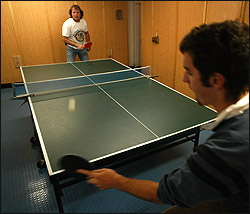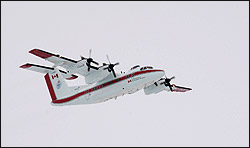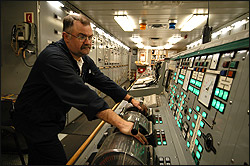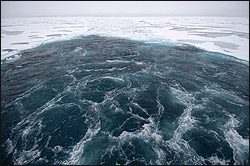Please note: You are viewing
the unstyled version of this website. Either your browser does not support CSS
(cascading style sheets) or it has been disabled. Skip
navigation.
Chris LinderAugust 24, 2005
As I passed Chief Engineer Ronald Collier in the passageway today, I asked him how the shaft repairs were going. He flashed a quick smile and held two crossed fingers in the air--"hopefully this afternoon!" His weren't the only crossed fingers--I think everyone on the ship, scientists and crew, have been counting on the engine department's expertise in repairing the starboard shaft. And what a job it was--six sixteen-hour days for the sixteen-man engine department. They took breaks for caffeine, food, and a bit of sleep (in that order), but otherwise they labored below decks on the biggest at-sea repair job any of them have ever tackled. While the repairs were being finished, we got a little outside help in our battle to escape the heavy pack ice. Just after lunch, the bridge piped an announcement "in a few minutes an ice recon plane will fly over us!" I grabbed my coat and camera and sprinted up to the broad deck on top of the pilothouse in time to see a white and red Dash-7 turboprop aircraft buzz by. It made one more loop around the Louis, flying only a few hundred feet over our heads, before zipping off into the clouds. I can't tell you how strange it is to see an aircraft, after three weeks of seeing nothing but ice and fog. This was no ordinary aircraft, either. It was a Canadian ice reconnaissance flight that the Captain and Ice Officer had requested. As Ice Officer Lucie Theriault explained to me "there is only so much you can tell from my Radarsat satellite ice images. There's just no substitute for the human eye." While we watched in amazement as the plane flew overhead, jpeg photos and hand-drawn ice maps were being transmitted via VHF radio from the plane directly to a receiver on the Louis. In a few minutes Lucie had printed out the images and was checking the ice conditions on our "escape route" out of the ice. The photos the flight crew took will help us find the easiest way out of the heavy ice. If we're lucky, we should be out of this thick multi-year ice in a day or two, and then the going will be much easier. Just before dinner, a felt a familiar hum through the decks. It started as a vibration I could feel in the soles of my shoes. The engines were started. I made my way through the maze of ladders and passageways to the engine control room. Jonathan Lee's smile was contagious. "That's the sound of success!" he exclaimed. Engineer Larry Colbert was about to start up the port and starboard propellers. With the flick of a couple of buttons and and a slow forward pressure on the throttle, the shafts sprang to life. "We're not there yet" he cautioned. "But I must admit, this all looks good." As we carefully eased off into the pack ice, Rick Krishfield bid a farewell to the two buoys we fought so hard to install yesterday. Rick can sleep easy tonight--he has already received confirmation from Woods Hole that they are both transmitting data with no problems. Now we are making all speed for Mooring C, the third Beaufort Gyre Observing System subsurface mooring. With a bit of luck we'll be on station in the morning and ready to go. After the Mooring C recovery we are hoping to redeploy it immediately. We are racing the clock now to finish as much of our science goals as possible in our limited time remaining. Last updated: October 7, 2019 | ||||||||||||||||||||||
Copyright ©2007 Woods Hole Oceanographic Institution, All Rights Reserved, Privacy Policy. | ||||||||||||||||||||||






